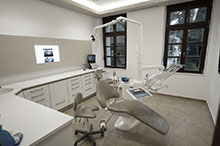Socket Preservation
Socket preservation is a procedure to reduce bone loss after tooth extraction and to preserve the dental alveolus (tooth socket) in the alveolar bone. A bone grafting material is placed in the socket of an extracted tooth at the time of extraction.[3][4] The socket is then directly closed with stitches or covered with a non-resorbable or resorbable membrane and sutured.[5]
After extraction, jaw bone has to be preserved to keep the socket in its original shape. Without socket preservation, the bone quickly resorbs resulting in 30-60% loss in bone volume in the six months after dental extraction. The jaw bone will never revert to its original shape once bone is lost and tissue contour has changed.
The human body reduces the amount of bone that is not sufficiently used with a daily stress; without the strain stimulus, the jaw bone behaves (with or without socket preservation) as if the space occupied by the tooth and periodontal ligament was empty.[6]
From Wikipedia, the free encyclopedia
• Tassos Irinakis, Rationale for Socket Preservation after Extraction of a Single-Rooted Tooth when Planning for Future Implant Placement, Journal of Canadian Dental Association 2006; 72(10):917–922
• Fickl, Stefan; Zuhr, Otto; Wachtel, Hannes; Stappert, Christian F. J.; Stein, Jamal M.; Hürzeler, Markus B. (2008). “Dimensional changes of the alveolar ridge contour after different socket preservation techniques”. Journal of Clinical Periodontology 35 (10): 906–913. doi:10.1111/j.1600-051X.2008.01305.x. ISSN 0303-6979.
• Extraction socket preservation: The time is now
• Hansson, S.; Halldin, A. (2012). “Alveolar ridge resorption after tooth extraction: A consequence of a fundamental principle of bone physiology”. Journal of Dental Biomechanics 3 (0). doi:10.1177/1758736012456543. ISSN 1758-7360.
Socket Preservation
Treatments
The Office

This is a modern dental clinic, with high-end equipment, adapted to the requirements of modern medicine in the dental field.




